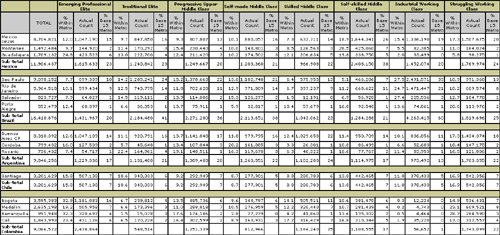Latin America, as a regional business unit, is a relatively new phenomenon. Until very recently Latin America was subject to multiple-country strategies. Companies might pursue increased business within individual countries, but did not consider the potential synergies and growth that could come from viewing these countries as a region.
Many managers of Latin American business now realize that there are advantages to pursuing a unified regional strategy -- including maximum levels of return on brands, products, service deployment and consumer cultivation. In fact, companies can reach Latin American consumers more effectively than ever before, but they must stop looking at Latin America as a collection of individual countries. Instead, companies must consider the needs and the socioeconomic realities of the eight consumer populations in the top metropolitan areas.
Until recently, obtaining a clear picture of the Latin American consumer posed some important challenges. Pablo Morales certainly understands these challenges. Morales was the president of a major appliance manufacturing company. Morales left his company, and Buenos Aires, for Miami to become the general manager for Latin American operations in another manufacturing firm. Like many professionals across the globe, he belongs to the new generation of marketers who live in a progressively integrated, emerging and increasingly unified market: a Latin America without borders. His story illuminates the necessary process for defining a Pan-American regional strategy. There are three initial challenges:
- Achieve maximum growth through higher share, higher margins, product line introductions, product line extensions, or all of the above.
- Allocate resources that are proportional to market size, are available for special new opportunities, and can be implemented according to the market strategy.
- Measure the effectiveness of regional marketing programs such as communication and advertising, promotions, brand management, new product introduction, commercialization, distribution and merchandising.
Step one: Focus on the top metropolitan areas
Because he was raised and educated in Buenos Aires, Morales had an acculturation problem -- his marketing point of reference had always been continental Europe, not the United States. He knew Paris well, but had never been to Bogota or Mexico City. How was he supposed to be responsible for a region he barely knew? How many books did he have to absorb to understand the differences between so many consumer groups? First, he began to think of "Latin America" as if it were one single market -- large metropolitan areas that, together, represent the lion's share of his business. This unified market is composed of 15 major cities, including:
- Mexico City, Monterrey and Guadalajara -- Mexico
- Sao Paulo, Rio de Janeiro, Salvador and Porto Alegre -- Brasil
- Buenos Aires, Rosario and Cordoba -- Argentina
- Bogota, Medellin, Cali and Barranquilla -- Colombia
- Santiago -- Chile
Rather than authoring a treatise on Latin American cultural differences, Morales focused on articulating a regional strategy.
Step two: Use purchasing power to estimate market potential
Morales knew that the per capita gross domestic product (GDP) in Argentina was around $7,500 (U.S.) and that Mexico's GDP was below $1,000 (U.S.). So, he initially deduced, the business potential presented by Mexico was much smaller than that of Argentina. He was wrong. Because of exchange rate fluctuations, a U.S. dollar in Mexico could buy 2.78 times more goods and services that that dollar would in the United States. In contrast, that U.S. dollar was worth only 99 cents in Argentina, 90 cents in Brasil, or $2.38 in Colombia. Purchasing power parities became a routine part of his financial analysis.
Step three: Account for the disproportionate distribution of income and consumption
The differences and commonalties among Latin American consumers are best explained by their socioeconomic status, not by nationality. In fact, nationality tells us very little about consumer attitudes because the distribution of income and consumption in Latin America is quite disproportionate. Brasil provides an extreme example -- the wealthiest 10% account for 52% of the country's income and consumption. Thus, it's impossible to market to Brazilians as a whole because Brazilians don't have common spending habits.
And that's not the worst of it. Morales tried to calculate and compare the number of consumers on each rung of each country's socioeconomic ladder. His task proved to be very difficult -- each country classified its socioeconomic identities differently, leaving him with no way to make comparisons between countries. What's more, not only does the terminology differ, the economic scales don't match from country to country.
A group of researchers at The Gallup Organization took Morales's predicament to heart. These scientists produced the first overview of the Pan-American socioeconomic ladder, which erases geographical and currency borders and replaces them with market groups. This instrument, the Socioeconomic Allocator, establishes that Latin America consists of eight distinct consumer groups (presented in the table below). The numbers in the first column represent the count of actual consumers in each of the metropolitan areas. These numbers are based on men and women ages 14 years or older with at least some disposable income, thus excluding 17% of the population. The Socioeconomic Allocator showed Morales that there are more than 50 million consumers in the 15 metropolitan areas.

|
In the next column, we will profile the eight consumer segments, and describe how companies can transform market intelligence into marketing applications in Latin America.


